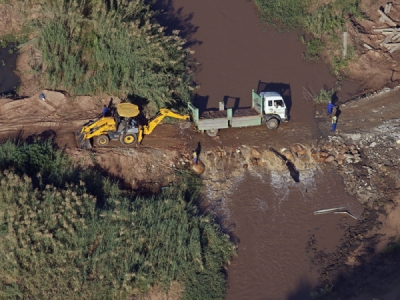
Posted on June 8, 2020
When the Courier visited excavation sites alongside the Umvoti River, there were at least five operators freely dredging sand directly from the depleted riverbeds using bulldozers and front-end loaders.
The Umvoti River remains the hotbed of illegal sand mining activity, retaining the notoriety it has earned over the past decade as an area of uncontrolled and unauthorised excavations.
Despite the Courier first reporting on the illegal operations almost seven years ago, those involved in illegal mining continue with their activities without showing any concern for the law.
Sand mining is a lucrative, age-old business that involves excavating sand from the riverbanks.
According to a North Coast builder, Umvoti River sand is considered among the best sands in South Africa for building purposes and is as good as gold in the construction industry.
Sand, like gold, diamonds and platinum, is a mineral regulated by law.

Several operators excavating sand at Umvoti river claimed to have legal permits but were unable to produce them.
It’s considered an ideal material for concrete production and is far superior to its alternatives, such as crushed stones, when working with concrete and mortar.
The barriers to entry in this market are low while profits on the sale of sand can be high.
When the Courier visited excavation sites alongside the Umvoti River, there were at least five operators freely dredging sand directly from the depleted riverbeds using bulldozers and front-end loaders.
The sand is then loaded onto waiting trucks for transportation.
Gaping pits can be seen along the riverbank where the operations appeared to be relatively unsophisticated and basic.
A local farmer, who wished to remain anonymous for fear of reprisal, said some of the known operators transported the extracted sand a short distance and sold it privately to individuals and companies.
“We know that local tribal authorities are giving permission to sand miners in these rivers without obtaining the necessary environmental authorisations. The number of operations occurring on a single system vary from 5 to as many as 10 on the Mvoti Estuary.
“Although these operators appear small and localised, they constantly move location, leaving behind unproductive and unrestored land,” said the farmer who has farmed in the region for more than two decades.
While at the site the Courier was approached by three men, who identified themselves as local community leaders, who offered to sell us a mining permit valid for six months at a cost of R150 000.
When questioned on the validity of the permits, the men assured us that they controlled the mining rights in the area and all operators bought their permits from them.
They insisted they did not need environmental authorisation through the mineral resources and energy department because the land “belongs to the community” and they controlled the mining rights.
Several operators claimed to have legal permits but were unable to produce them.
The extraction of sand is protected by the Mineral and Petroleum Resources Development Act of 2002 that stipulates that anyone wishing to mine sand needs to apply for a permit from the mineral resources and energy department.
It appears this regulation is largely ignored.
According to the department it is a crime to mine without a licence.
The permits are aimed at controlling prospecting, mining and environmental management. Operators are also required to rehabilitate the area mined.
Dolphin Coast Conservancy chairperson Di Jones said demand for sand was high, as rapid urbanisation has created a boom for this increasingly valuable resource that was unlikely to let up.
“The replenishment of beach sand is highly dependent on sediment transport from upstream river catchments and several scientists have raised concerns that the extraction of sediment from rivers and estuaries by sand miners could upset this balance,” said Jones.

Sand mining operators freely dredging sand directly from the depleted Umvoti riverbed using bulldozers and front-end loaders.
A recent study conducted by the Ocean Research Institute (ORI) that was presented to Environment, Forestry and Fisheries department (DEFF) inaugural Integrated Coastal Management (ICM) lekgotla in September revealed that at least half of KZN’s coastal rivers and estuaries have been affected by sand mining over the past decade.
An examination of satellite imagery shows the extraction depletes the sediment and nutrient supply to the downstream marine environment, starving beaches and dunes of sand and accelerating coastal erosion.
“Sand mines are extensive, at times reaching nine hectares. In addition to the loss of estuarine habitat these systems are the most critical to the delivery of sand to the provinces’s beaches and mining has resulted in a substantial sand deficit that has been linked to coastal erosion on Durban’s tourist beaches.”
Since it takes many hundreds of years for sand to form from the weathering of rock, it is essentially a non-renewable resource and its continued unsustainable extraction from the environment will lead to depletion.
The Water and Sanitation department provincial head, Ashley Starkey, said companies needed to have water-use licences from the department and also mining licenses from the mineral resources and energy department. It is illegal to mine sand without both the licences.
Source: northcoastcourier.co.za





